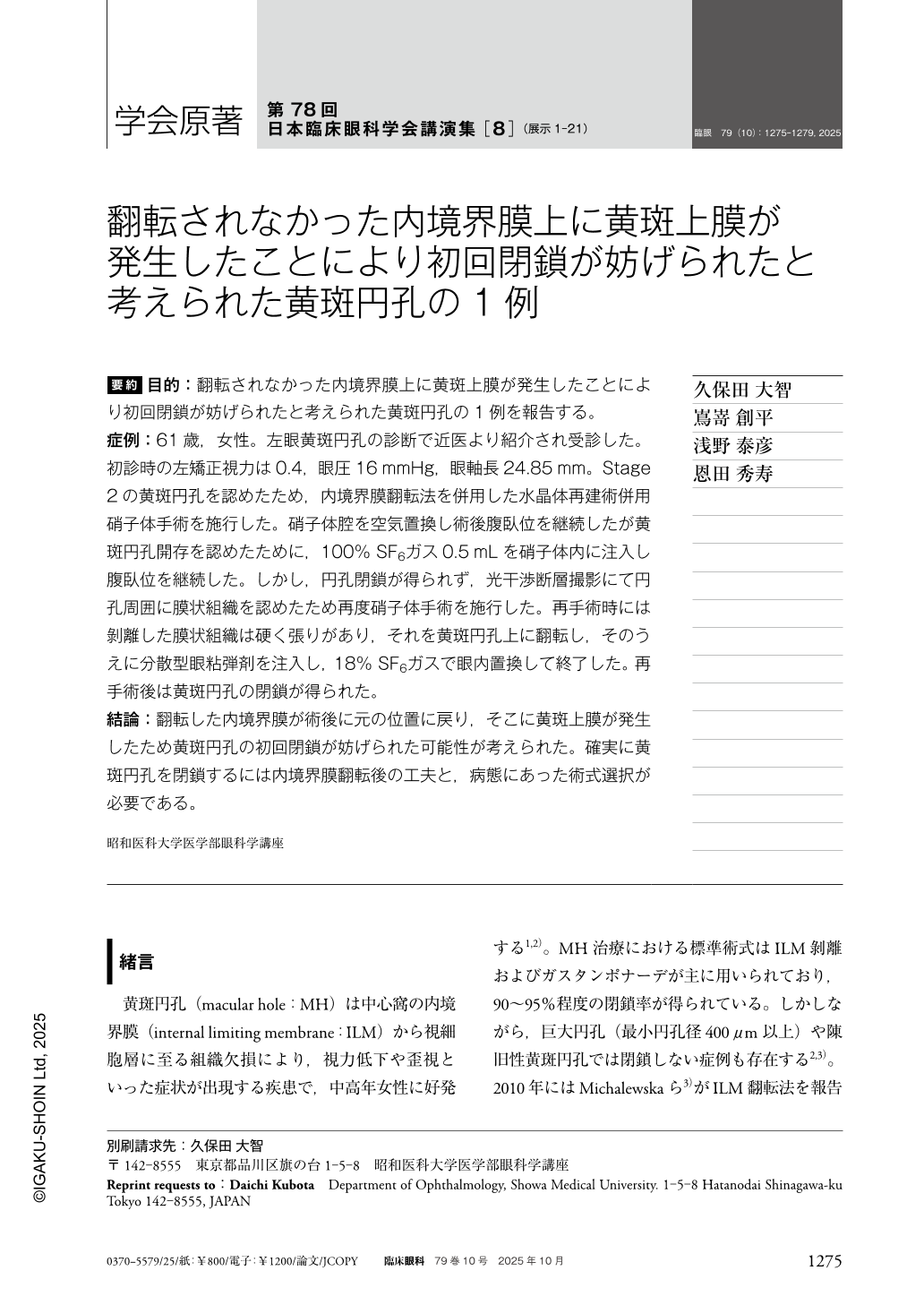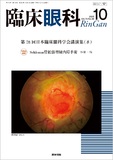Japanese
English
- 有料閲覧
- Abstract 文献概要
- 1ページ目 Look Inside
- 参考文献 Reference
要約 目的:翻転されなかった内境界膜上に黄斑上膜が発生したことにより初回閉鎖が妨げられたと考えられた黄斑円孔の1例を報告する。
症例:61歳,女性。左眼黄斑円孔の診断で近医より紹介され受診した。初診時の左矯正視力は0.4,眼圧16mmHg,眼軸長24.85mm。Stage 2の黄斑円孔を認めたため,内境界膜翻転法を併用した水晶体再建術併用硝子体手術を施行した。硝子体腔を空気置換し術後腹臥位を継続したが黄斑円孔開存を認めたために,100% SF6ガス0.5mLを硝子体内に注入し腹臥位を継続した。しかし,円孔閉鎖が得られず,光干渉断層撮影にて円孔周囲に膜状組織を認めたため再度硝子体手術を施行した。再手術時には剝離した膜状組織は硬く張りがあり,それを黄斑円孔上に翻転し,そのうえに分散型眼粘弾剤を注入し,18% SF6ガスで眼内置換して終了した。再手術後は黄斑円孔の閉鎖が得られた。
結論:翻転した内境界膜が術後に元の位置に戻り,そこに黄斑上膜が発生したため黄斑円孔の初回閉鎖が妨げられた可能性が考えられた。確実に黄斑円孔を閉鎖するには内境界膜翻転後の工夫と,病態にあった術式選択が必要である。
Abstract Purpose:To report a case of a macular hole in which initial closure was hindered by epiretinal membrane formation on a non-inverted internal limiting membrane.
Case Report:A 61-year-old woman was referred to our institution with a macular hole in her left eye. At the initial visit, her best-corrected visual acuity in the left eye was 0.4, intraocular pressure was 16 mmHg, and the axial length was measured to be 24.85 mm. Optical coherence tomography(OCT) revealed a stage 2 macular hole. The patient underwent vitrectomy combined with cataract surgery, incorporating the ILM flap inversion technique. The vitreous cavity was air-filled, and postoperative prone positioning was maintained;however, the macular hole remained open. Subsequently, 100% SF6 gas(0.5 ml) was injected into the vitreous cavity, and prone positioning was continued. Despite these measures, the holes failed to close. OCT revealed a membrane-like structure around the macular hole, prompting a second vitrectomy. During the reoperation, the detached membrane-like tissue was firm and taut. This tissue was inverted over the macular hole, and a dispersive ophthalmic viscoelastic device was applied, followed by an 18% SF6 gas tamponade. Successful closure of the macular hole was achieved postoperatively.
Conclusion:The failure of initial macular hole closure may have been due to postoperative repositioning of the inverted ILM, which led to the formation of an epiretinal membrane over the macular hole. To ensure successful closure, it is essential to refine the technique after ILM inversion and select an appropriate surgical strategy based on the patient's pathological condition.

Copyright © 2025, Igaku-Shoin Ltd. All rights reserved.


